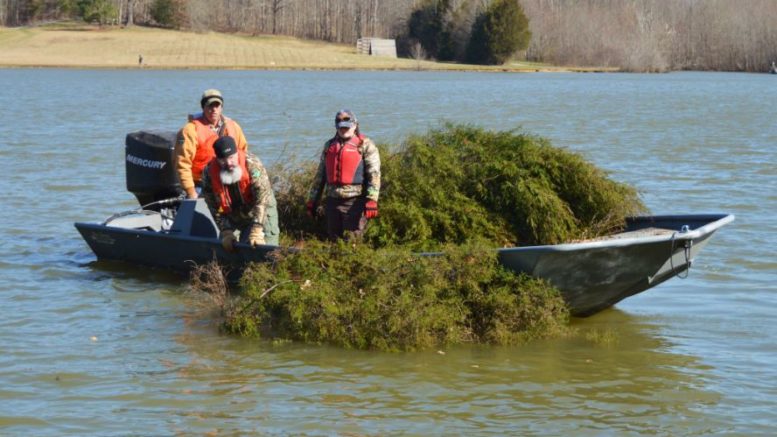Image: Tennessee Wildlife Resources Agency’s Jack Swearengin, left, and Mark Thurman, along with Jennifer Caudle of the Tennessee Tech Student Fisheries Association, sink brush into the lake at Cane Creek Park. Other types of fish attractors have also been added to improve fishing
COOKEVILLE – Some cedar brush here, a stake bed there.
That’s what it takes to make fish – and fishermen – happy.
“It puts anglers and fish together, which is what we really want,” Mark Thurman, Tennessee Wildlife Resources Agency Region 3 fisheries program manager, said.
TWRA recently partnered with Cookeville Leisure Services, Tennessee Tech University Student Fisheries Association, TTU Bass Fishing Team and U.S. Geological Survey to improve fishing opportunities at Cane Creek Park by installing a variety of fish attractors in the 56-acre lake.
“We scouted the area, looking at the depths around the lake, and we found some sites we wanted to work with,” Thurman said.
The project began when TTU’s Bass Fishing Team applied for a Friends of Reservoirs grant for several Mossback fish habitats, which are artificial habitats that consist of intersecting, V-shaped limbs rising from a triangular base.
“They’re made out of a high-quality, long-lasting plastic,” Thurman, who had provided a letter of support for the grant, said. “They’re meant to simulate a tree or a cluster of roots.”
After the grant was awarded, the project was expanded to include additional structures of the natural sort – brush and wooden stakes.
“I’m really excited about it,” Thurman said. “A lot of fishing takes place here, and it’s important to manage it in a way that provides good fishing for folks. Sometimes that’s a challenge in small lakes because of the lack of cover. So we’ve added some cover. It should make a difference.”
TWRA representatives gathered with USGS’s Mark Rogers, Cane Creek Park’s Ed Hollingsworth and several TTU students in late March to put the fish attractors in place.
The Mossback fish habitats, 14 in all, were installed along the north bank of the lake parallel to the walking trail. The structures will promote algae and plant-like growth that resembles the look and feel of natural cover for the fish.
Cedar brush was submerged in various places, including the fishing pier just off the trail as well as both corners of the dam. While not as long-lasting as the artificial habitats – woody debris needs to be replaced every five to eight years – it will provide the ground cover and shade that fish desire.
Numerous stake beds are visible in the lake. These structures, drilled into the mud bottom, provide spawning habitats and cover for young fish.
Each type of habitat will become a place for fish to congregate, thus creating prime fishing spots.
“It’ll really improve our fishing program,” Hollingsworth, who provided the brush for the project, said.
Rogers, who also advises TTU’s Bass Fishing Team, added, “Cane Creek Park is a really great local fishing area, and there’s great access all around the lake. So what we wanted to do was improve that habitat and the fishing for the community.”
Rogers noted the benefits for the TTU students who assisted with the project.
“First of all, they get one-on-one contact with TWRA,” he said. “Second, they get to do something for the Cookeville community. Everybody’s winning.”
Among the students were Jennifer Caudle and Jared Allen, both of the Student Fisheries Association.
Caudle, who is working toward a master’s degree in biology, spent much of the day on a boat with TWRA officials helping to sink the cedar brush.
“Putting out fish attractors is important to help anglers with their experience,” she said. “A lot of what TWRA does is for anglers and other areas of natural resources. So, these fish attractors will give the fish a place to hang out close to the bank so that people can get their lures out to them.”
Allen, a junior wildlife and fisheries science major, helped assemble the Mossback fish habitats.
“There wasn’t much cover in this lake, so this will definitely help with the smaller fish as they try to grow and make it into adulthood,” he said.
Cane Creek Park, located at 201 C C Camp Road, has two fishing piers and a boat ramp for non-motorized boating. A Tennessee Fishing License is required for anglers ages 13 and up. For more details, visit www.tn.gov/twra.
For more information about the park, call 931-520-4386.

